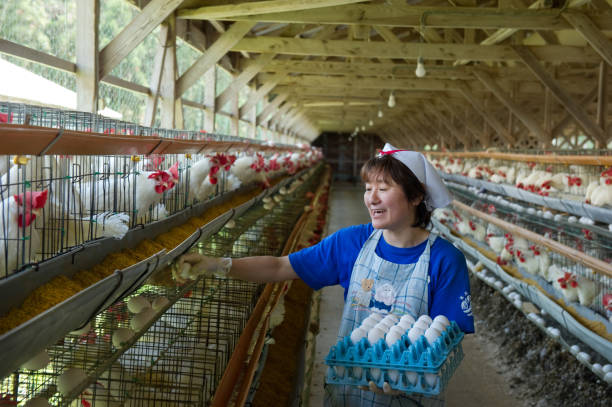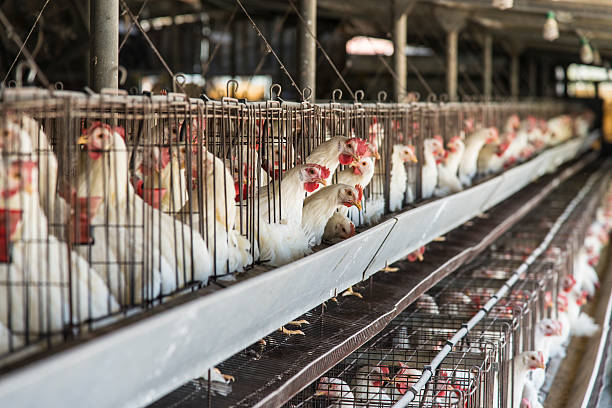
10,000 Layer Farm in Algeria: Cost-Effective Solutions for Housing and Feeding
10,000 Layer Farm in Algeria: Cost-Effective Solutions for Housing and Feeding

Algeria’s poultry industry is experiencing a notable upswing, driven by increasing domestic demand for eggs and a growing awareness of the nutritional benefits of poultry products. As a result, establishing a 10,000-layer farm in Algeria presents a compelling business opportunity. However, success hinges on implementing cost-effective solutions for housing and feeding, the two largest operational expenses. This article delves into practical strategies for optimizing these crucial aspects of layer farming in Algeria, focusing on maximizing efficiency, minimizing costs, and ensuring the long-term sustainability of your operation.
Understanding the Algerian Layer Farming Landscape

Before diving into specifics, it’s crucial to understand the Algerian agricultural context. Algeria’s climate varies significantly across the country, from the fertile coastal regions to the arid Sahara Desert. This climatic diversity dictates the housing requirements for layer hens. The availability and cost of feed ingredients also fluctuate depending on local agricultural production and import policies. Aspiring poultry farmers must conduct thorough market research to identify reliable feed suppliers and understand the prevailing market prices for eggs. Government regulations and support programs also play a role in shaping the profitability of layer farms. Familiarizing yourself with these factors will enable you to make informed decisions regarding housing and feeding strategies.
Housing Solutions: Balancing Cost and Hen Welfare
Choosing the right housing system is paramount for a successful 10,000-layer farm. There are three primary options: free-range, deep litter, and cage systems. Each has its own set of advantages and disadvantages in terms of cost, space requirements, labor intensity, and hen welfare.
Free-Range Systems: While free-range systems appeal to consumers who prioritize animal welfare, they are often the most expensive to establish and manage. The land requirement for 10,000 hens is significant, and the risk of predation from wild animals is higher, requiring robust fencing and vigilant management. Furthermore, free-range hens are more susceptible to diseases and parasites, increasing veterinary costs. While this appeals to some consumers, it is not the most cost-effective decision for those looking at ROI.
Deep Litter Systems: Deep litter systems provide more space than cage systems but less than free-range. Hens are housed on a bed of organic material, such as wood shavings or rice husks, which absorbs manure and provides insulation. Deep litter systems are less expensive to set up than free-range but require more labor for management. Maintaining the litter in good condition is crucial to prevent the build-up of ammonia and moisture, which can negatively impact hen health. Disease risk is also higher compared to cage systems. Initial investment is also not cheap as you would need to prepare the bedding and housing.
Cage Systems: Cage systems, particularly battery cages and enriched cages, remain a popular choice for commercial layer farms due to their cost-effectiveness and efficiency. Battery cages offer the highest stocking density but are increasingly criticized for their negative impact on hen welfare. Enriched cages, also known as furnished cages, provide hens with more space, perches, and nesting areas, addressing some of the welfare concerns associated with battery cages.
For a 10,000-layer farm in Algeria aiming for cost-effectiveness, enriched cage systems offer the best balance between productivity, hen welfare, and affordability. These cages allow for efficient egg collection, reduced labor costs, and better control over the environment, minimizing disease outbreaks and maximizing egg production.
Optimizing Cage System Design for Algerian Conditions
When selecting a cage system, it’s vital to consider the specific climatic conditions in Algeria. In hot regions, adequate ventilation is crucial to prevent heat stress, which can significantly reduce egg production. Cage designs that incorporate natural ventilation or mechanical ventilation systems are recommended. Proper insulation of the poultry house is also essential to maintain a stable temperature during both hot summers and cold winters. Ensure the house is oriented to minimize direct sunlight exposure during peak hours. Furthermore, the cage material should be durable and resistant to corrosion, especially in coastal areas where humidity is high.
Livi Machinery offers a range of cost-effective layer cage systems specifically designed for African climates. Their A-type and H-type layer cages are made from high-quality galvanized steel, providing excellent durability and corrosion resistance. The cage designs incorporate features that promote optimal ventilation and ease of management. Livi Machinery also offers automated feeding and drinking systems, further reducing labor costs and improving efficiency.
Feeding Strategies: Minimizing Costs Without Compromising Quality
Feed represents the largest operational expense in layer farming, accounting for up to 70% of the total cost. Therefore, implementing cost-effective feeding strategies is crucial for maximizing profitability.
Sourcing Local Feed Ingredients: Relying solely on imported feed ingredients can significantly increase costs. Exploring opportunities to source locally produced feed ingredients, such as maize, wheat bran, and soybean meal, can substantially reduce feed expenses. Conduct thorough research to identify reliable local suppliers and ensure the quality of the ingredients.
Formulating a Balanced Feed Ration: A well-balanced feed ration is essential for optimal egg production and hen health. Layer hens require a specific balance of protein, energy, vitamins, and minerals. Consulting with a poultry nutritionist is highly recommended to develop a feed formulation that meets the hens’ nutritional requirements while minimizing costs. Avoid overfeeding expensive protein sources and optimize the use of cheaper energy sources.
Implementing Efficient Feeding Practices: Minimizing feed waste is crucial for cost control. Use properly designed feeders that prevent spillage and ensure that all hens have access to feed. Implement a feeding schedule that aligns with the hens’ natural feeding patterns. Regularly monitor feed consumption and adjust the feeding rate as needed to avoid overfeeding or underfeeding. Automated feeding systems can significantly reduce feed waste and labor costs.
Livi Machinery’s automated feeding systems are designed to deliver precise amounts of feed to each cage row, minimizing waste and ensuring uniform feed distribution. The systems are easy to operate and maintain, further reducing labor costs.
Water Management: Ensuring Availability and Preventing Waste
Water is essential for layer hen health and egg production. Ensuring a reliable and affordable water supply is crucial for the success of a 10,000-layer farm.
Water Source: Explore various water sources, including groundwater, surface water, and municipal water. Groundwater is often the most readily available and affordable option, but it’s essential to test the water quality to ensure it’s safe for consumption. Surface water may require treatment to remove contaminants.
Water Storage: Install adequate water storage tanks to ensure a continuous water supply, especially during periods of drought. Choose tanks made from durable and food-grade materials.
Watering System: Nipple drinking systems are the most hygienic and efficient option for layer hens. Nipple drinkers minimize water spillage, preventing wet litter and reducing the risk of disease outbreaks. Ensure that the water pressure is appropriate for the hens’ age and that the nipples are easily accessible. Regularly clean and disinfect the watering system to prevent the build-up of algae and bacteria.
Livi Machinery’s nipple drinking systems are designed for optimal water flow and hygiene. The nipples are made from high-quality stainless steel, ensuring durability and preventing corrosion. The systems are easy to install and maintain, providing a reliable and affordable water supply for your layer hens.
Disease Prevention: Maintaining Hen Health and Productivity
Disease outbreaks can have a devastating impact on egg production and profitability. Implementing a comprehensive disease prevention program is essential for maintaining hen health and minimizing losses.
Biosecurity: Strict biosecurity measures are crucial for preventing the introduction and spread of diseases. Control access to the poultry farm, implement a foot bath at the entrance, and restrict the movement of vehicles and equipment. Quarantine new birds before introducing them to the flock.
Vaccination: Develop a vaccination program in consultation with a veterinarian. Vaccinate hens against common diseases, such as Newcastle disease, infectious bronchitis, and avian influenza.
Hygiene: Maintain a clean and hygienic environment in the poultry house. Regularly clean and disinfect the cages, feeders, and waterers. Remove manure promptly and dispose of it properly. Control rodents and insects, which can transmit diseases.
Monitoring: Regularly monitor the hens for signs of illness. Early detection and treatment can prevent the spread of disease and minimize losses. Consult with a veterinarian promptly if you suspect a disease outbreak.
Waste Management: Environmentally Responsible Practices
Proper waste management is essential for protecting the environment and maintaining good relations with the local community.
Manure Management: Manure can be used as a valuable fertilizer for agricultural land. Properly compost the manure to reduce odor and kill pathogens. Store composted manure in a covered area to prevent runoff and contamination of water sources.
Water Management: Prevent water pollution by properly treating wastewater from the poultry house. Implement water conservation measures to reduce water consumption.

Conclusion: Building a Sustainable and Profitable Layer Farm
Establishing a 10,000-layer farm in Algeria requires careful planning and execution. By implementing cost-effective solutions for housing and feeding, you can maximize profitability and ensure the long-term sustainability of your operation. Choosing the right cage system, sourcing local feed ingredients, implementing efficient feeding practices, ensuring a reliable water supply, and maintaining a strict disease prevention program are all crucial for success. Partnering with reputable suppliers like Livi Machinery can provide you with the necessary equipment and expertise to build a thriving layer farm in Algeria. Remember that continuous learning and adaptation are essential to stay ahead in the ever-evolving poultry industry. Stay informed about the latest advancements in poultry farming technology and management practices, and adapt your strategies accordingly. By focusing on efficiency, sustainability, and hen welfare, you can build a prosperous and responsible layer farm that contributes to Algeria’s growing poultry industry.
